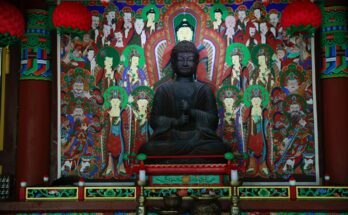Buddhism: foundations and evolution
Throughout the more than forty years that passed between the Buddha’s enlightenment and parinirvana, he imparted vast and frequent teachings that addressed the key philosophical problems of what reality is and how we might know it. His philosophy is today known as Buddhism. While moral behavior and mental training are vital components of our lives, comprehending the essence of reality is just as significant. We suffer, to put it simply, because we misinterpret reality.
Philosophy and essence of Buddhism
Image via Unsplash.com
The nature of reality has always been the central concern of Buddhist philosophy. Scholars have been studying the teachings of the Buddha for more than 2,500 years in an effort to pinpoint the nature of this reality. When discussing the nature of things and our perception of them, Buddhist philosophy distinguishes between two types of truths: the ultimate truth and the conventional, or relative, truth.
It is difficult to grasp the core ideas of Buddhist thinking. Many ideas are foreign to us and many are quite subtle, taking time or effort to become clear. In due course, things will become more evident if we can recognize how important this comprehension is and put in the necessary effort.
Origin of sufferings and Buddhism
Why do we commit errors? To realize that we suffer because we are unable to perceive the nature of things, we must investigate this crucial question. All of our problems stem from the very subtle misinterpretation of ourselves, other people, things like our possessions, life events, and other entities that make up our world. This misinterpretation of reality is the root cause of all of our problems. We refer to the disparity as ignorance.
Things and events make up the cosmos. At one level, we are unmistakably biased in our perceptions of the great majority of things, even though some of them may be pure delusions or just nonexistent. That is the accepted reality. On a more subtle level, though, we mistakenly attribute to them a tangible actuality and fail to recognize how they arise as a result of causes and conditions. At this “ultimate” degree of depth, the mode of existence of phenomena represents ultimate truth.
Vision and reality
Image via Unsplash.com
We form opinions, make mistakes, and endure consequences when we act on false information. Our ability to perceive reality accurately will enable us to make more informed decisions, which will lead to fewer errors and less pain. But because our regular misinterpretation of reality is so ingrained, it cannot be healed by merely studying it once. To truly connect with the core of Buddhist philosophy and integrate it into our daily lives to the extent necessary to overcome our negative patterns, it takes time.
This is not a mind game that’s intriguing but unimportant, nor is it abstract philosophy. The secret to true happiness is this. We will always reify things and circumstances, which will lead to the development of attachment and aversion as long as we are caught up in false beliefs about the nature of reality—specifically, as long as we believe that our own sense of identity is constant and unchanging. We are unable to assist others and, ironically, cannot find happiness because we are trapped in a worldview in which the “I” is central and everything else is subservient to the “I.”
Taming the emotions and Buddhism
The goal of Buddhist philosophy is to help us develop our brains to their full potential by giving us a true understanding of the way the world works. We must unite this rational aspect with our innate emotional side. Our emotions won’t get us very far on their own.
Without compassion, our self-centered thoughts will, ironically, drive us to hurt both other people and ourselves. But compassion is misguided if it is not grounded in a correct understanding of reality. We have all encountered kind-hearted yet incredibly unsophisticated individuals who, in spite of their best efforts, appear to inflict more harm than good.
Contemplation and meditation
Image via Unsplash.com
First and foremost, it is crucial that we read, listen, and talk about the different subjects we are learning. There is nothing to think about without sufficient knowledge. And if there is nothing to think about, there is nothing to concentrate on. It is like a fingerless person trying to climb a mountain of ice. To use the somewhat harsh classic comparison, with nothing to grab on to and nowhere to hold.
We will require a wide range of abilities as we set out on this exploration into the nature of reality. It is necessary to use some discrimination when reading and listening. So that we can separate the texts that are true from those that could mislead us. We also require persistence since we will need to study them and again hear lessons on them from knowledgeable masters in order to understand their true significance.
To explore what we have heard, learn as much as we can about it. And gain as thorough an understanding of it as possible is the definition of contemplation. The third of the three steps to understanding can only begin when we are prepared to begin our meditation. As you can see, meditation is applied rather late in the procedure. This is not to argue that you shouldn’t start sincerely working on honing your essential meditation techniques right away. But aside than closing our eyes and remaining motionless in silence, there isn’t much to meditate on unless one has a reasonably thorough comprehension of the subject.
Evolution of Buddhist thought

Image via Pexels.com
It would seem from history and reasoning that one school developed from another. And that many viewpoints were “created” throughout time by various scholars. Yet, we must be absolutely clear that the Buddha taught all of the lessons presented here. The Buddha is the source of all philosophical subfields studied in Tibetan monasteries. In addition to the Pali sutras studied in the Theravada schools, he taught the Buddha Nature Sutra (Tathagatagarbha Sutra). And from the third turning of the Dharma wheel and the Perfection of Wisdom (prajñaparamita) sutras from the so-called second turning.
USEFUL LINKS:
Click here to read more
Formation of Islamic image in the West







